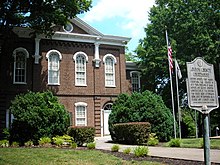Loudon County, Tennessee
| Loudon County, Tennessee | |
|---|---|

The Loudon County Courthouse in Loudon
|
|
|
Location in the U.S. state of Tennessee |
|
 Tennessee's location in the U.S. |
|
| Founded | 1870 |
| Named for | Fort Loudoun |
| Seat | Loudon |
| Largest city | Lenoir City |
| Area | |
| • Total | 247 sq mi (640 km2) |
| • Land | 229 sq mi (593 km2) |
| • Water | 18 sq mi (47 km2), 7.3% |
| Population (est.) | |
| • (2015) | 51,130 |
| • Density | 212/sq mi (82/km²) |
| Congressional district | 2nd |
| Time zone | Eastern: UTC-5/-4 |
| Website | www |
Loudon County is a county located in the U.S. state of Tennessee. As of the 2010 census, the population was 48,556. Its county seat is Loudon.
Loudon County is included in the Knoxville, TN Metropolitan Statistical Area.
Loudon County was formed on May 27, 1870, from portions of Roane, Monroe and Blount counties. Originally, it was named Christiana County, but a few days later the name was changed to Loudon in honor of nearby colonial-era Fort Loudoun. The fort was named for John Campbell, 4th Earl of Loudoun and a commander of British forces during the French and Indian Wars. In August 1870, the county officers were chosen. On September 5, 1870, the county court was organized at the Baptist Church in Loudon. This church became the temporary quarters of the county court until the new building, built by J. W. Clark & Brothers, was finished in 1872.Bussell Island, at the mouth of the Little Tennessee River, was inhabited by Native Americans for several thousand years before the arrival of the region's first European settlers. The Overhill Cherokee village of Mialoquo was located along the Little Tennessee near modern Tellico Village. Fort Loudoun was constructed by the British near modern Vonore in 1756, and was destroyed by the Cherokee four years later.
One of the earliest American settlements in what is now Loudon County was a river port and ferry known Morganton, once located on the banks of the Little Tennessee River near modern Greenback. Morganton thrived during the early 19th century, but declined with the rise of the railroad in the latter half of the century. The town's remnants were inundated by Tellico Lake in the 1970s.
...
Wikipedia
